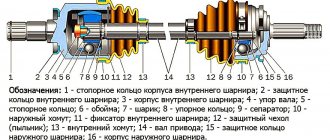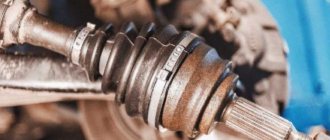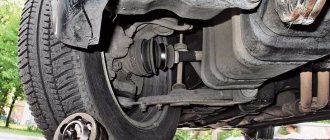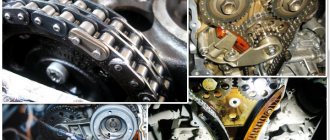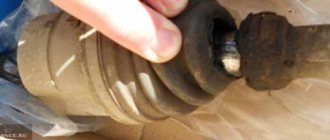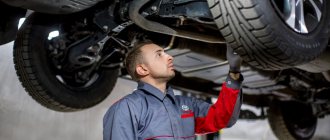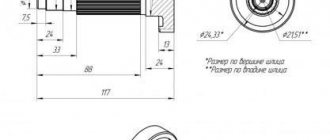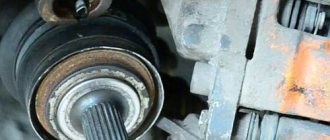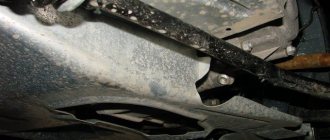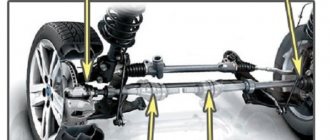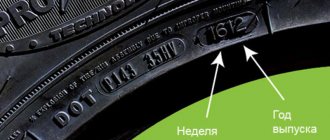Every experienced driver always listens to various sounds while operating his car. The appearance of uncharacteristic knocking or humming may indicate the presence of some kind of malfunction. Prompt diagnostics in most cases helps to significantly save your money on further repairs.
In cars with front-wheel drive and all-wheel drive, problems often arise with the CV joint (constant velocity joint). Such parts are made from high-quality metal alloys, but even this does not prevent possible damage. The main sign of a malfunction in this component is the appearance of a specific crackling sound.
A little about the nature of the problem
A CV joint is necessary to transmit rotation between the axle shafts with a constant change in the angle between them. The part is used in front-wheel drive and all-wheel drive vehicles. The drive wheel in such cars must not only rotate, but also turn, and also lower and rise on a spring. Such hinges allow you to do all this.
The design of this unit consists of three main components:
- The outer housing, which is made in the shape of a bowl and is connected to the axle shaft.
- Inner ring. It has a spherical shape. There are six grooves on it, thanks to which the clip is attached to the outer casing.
- Six small balls in the separator. They are located between the bowl holder and the machines.
The problem is that during operation, with the constant “walking” of the balls in the structure, wear and small scuffs form. The movement of the balls becomes more free, which leads to a characteristic sound. Even inexperienced drivers will be able to determine the presence of this problem. You may hear clicking sounds accompanied by vibration or whistling. In most cases, the sound will resemble the crunching of metal.
Common causes of knocking noise associated with the steering mechanism
Now let's look at typical problems and how to fix them.
The first thing you need to do is check the pressure in the wheels, because the difference in tire inflation may be the cause of the knocking.
Then check the fastening of the plastic protective fender liners. It is quite possible that the screws that secure them to the body have broken out, causing the fender liner to come off and cling to the wheel, making a knocking sound when turning.
POPULAR WITH READERS: ZIL-157, spare parts catalog
In general, such a malfunction is very easy to fix; all you need to do is secure the torn fender liner with new screws.
The most dangerous from a safety point of view is the appearance of a knock in the steering mechanism itself. To check the condition of the mechanism, you will need to drive the car onto an overpass.
The first thing you need to check is the steering ends. Damage to the tip boot leads to sand getting inside it, which intensively wears out the surfaces of this element, causing play to appear in the tip, which is the source of knocking.
You can check the condition of the ends by loosening the tie rod with a pry bar.
Strong play and knocking will indicate wear on the tip and the need to replace it.
Steering ends for domestic cars are relatively inexpensive, and you can purchase them at almost any auto store.
Replacing them is also easy. It is recommended to replace both tips at once.
The complexity of performing this work comes down to the need to use a special puller.
After replacing the tips, you will still have to contact a service station to set the wheel alignment angles.
A knock may also appear in the steering rod silent blocks. They are located in the place where these rods are attached to the steering rack.
Delamination of the rubber of these silent blocks can also lead to knocking, although it will appear not only when turning, but constantly while driving.
This steering mechanism malfunction, although very rare, is still possible. It can be eliminated by removing the steering rods and pressing in new silent blocks.
A knock may also appear in the steering mechanism itself. It usually forms after the rack guide bushings wear out, causing a gap to appear between the rack and gear.
In some cases, everything can be eliminated by removing the gap with the mechanism's adjusting bolt.
If this is no longer possible, you will need to remove the mechanism from the car, disassemble it and replace the worn guide bushings.
A knock may even appear in the steering column universal joint.
If for some reason it is damaged, it is quite possible that it is the cause of the appearance of third-party sounds. This problem is “treated” by replacing the cardan.
You should also check the fastening of the mechanism body to the car body. Loose clamps may cause noise. This can all be eliminated by tightening the fastening nuts.
Is the CV joint really to blame?
As soon as you hear a crunching sound in your car, you should not draw any clear conclusions, because the source may be some other component. The involvement of constant velocity joints can be determined in two ways.
Turn the wheels of your car all the way to the side, and then try to drive off in this position. If in this particular situation a crunching sound is heard, then the problem is really in the hinges. This problem can also occur when overcoming small obstacles, for example, potholes on a country road. There will be increased stress on the CV joints and you should hear crunching sounds.
Reasons for appearance
Before we talk about how to determine which CV joint is crunching, it is necessary to find out the most common causes of this problem. Correct diagnosis greatly simplifies repairs. The key reasons for this phenomenon include:
- Defective part. At a car service center, you could have had a CV joint installed that was not made to the standards, which is why there were gaps from the factory. In this situation, the best solution would be to completely replace the CV joint.
- Lack or insufficient amount of granite lubricant. It is recommended to replenish it to the required volume.
- Severe wear on the anthers. During operation, these components lose their elasticity, which is why sand, dirt, water and dust get into the hinge structure. All of them lead to the appearance of a specific crunch.
- Aggressive driving style. In such situations, a very large load is placed on the hinges, which significantly reduces their service life. With constantly aggressive driving, the crunch will not take long to occur.
Even a European car breaks down
You might think that all of the above-described malfunctions are characteristic exclusively of the Russian automotive industry. In fact, everything is completely different - even an expensive foreign car cannot be saved from breakdown. The whole point is also how often this will happen.
Currently, it can already be seen that the quality of the Russian automobile industry has improved significantly. For example, Renault Logan cars recently began to be produced in Russia - there are no problems with quality. To avoid suffering from car breakdowns, experts advise the following: you need to go for a full diagnosis at least once every month or two for the first six months, but there is no need to lead to symptoms (knocking, grinding and crackling noises).
Also, breakdowns largely occur due to poor-quality road surfaces. As you know, roads in Europe are much better than in Russia. For this reason, cars there are operated under more gentle conditions than here.
How to find out which CV joint is crunching
Each wheel has two hinges: internal and external. This significantly complicates the diagnostic process, since they are located next to each other, so it is almost impossible to determine by ear which of the components makes sounds. A few tips will help you find out which CV joint is crunching (internal or external):
- Turn off the vehicle, and then use a flashlight to locate the hinge pins. Pull them one at a time without applying much force. If no play is detected, then the part is fully operational. If a large amount of wear occurs, your actions will lead to a crunching sound, which will help diagnose the failure of a particular hinge.
- The second method allows you to diagnose a breakdown of the external hinge. You need to drive onto a flat road, and then turn the wheels to the side until they stop. If at this moment you hear a characteristic sound, then the problem is in the internal CV joint. The left part is worn out when there is a sound when turning right. With the right part there will be a sound when turning left. This is due to the fact that when turning, the entire weight of the car falls on the opposite side of the turn.
Silent blocks crunch
This is a common malfunction of rubber-to-metal joints, especially in hot summer weather. At elevated air temperatures, silent blocks may creak, which indicates the need to check and replace them.
The creaking or crunching of silent blocks on a summer day occurs due to drying out of the hinges. The main material of these units is rubber. At elevated temperatures, it dries out and decreases in volume, especially if these nodes are already old.
There is no particular danger in the crunching of silent blocks until the rubber breaks. It is necessary to remove the silent blocks and carry out a visual inspection. If cracks or damage are found, they should be replaced. If no problems are found, then they should be put in their place and continue to enjoy driving the car, hoping that soon the air will become cooler and the squeak will disappear.
Diagnostics of the internal CV joint
It can be quite difficult to determine the malfunction of this component, and sometimes it is impossible to do without the help of specialists.
Drivers can try a number of tests to try to determine if this part is faulty on their own. To do this, you need to find a straight road with small potholes. Drive along it without turning. If you hear a familiar sound, this indicates a clear failure of the internal joint.
You can also load the rear of the car (with passengers or luggage) so that the front of the car rises. In such a situation, the axis of the inner CV joint will bend, so when driving even on a flat road, characteristic sounds should be heard.
Is it possible to drive if the CV joint crunches?
There is no clear answer to this question, since the component can only be partially worn out, so it will still last a certain number of kilometers without any consequences. If a crunching sound occurs, all experts strongly recommend contacting service, as delay can lead to more serious consequences, which include:
- Structure jamming. The hinge stops rotating completely. This is extremely dangerous when driving at high speed. Losing control of a car can lead to death and a traffic accident.
- Broken axle shaft or shaft. No torque will be supplied to the wheels, making it impossible to continue driving your vehicle. There is also always the danger that a rupture will damage other components in the immediate vicinity.
In most cases, a complete replacement of the constant velocity joints is necessary, however, with minor wear, drivers can carry out a number of works that will help eliminate the crunching noise. These include:
- checking the integrity of the anthers and replacing them in case of wear;
- cleaning the structure, replacing lubricant;
- in some cases, you can try sanding the surface to eliminate play.
How to determine a CV joint failure
There are two CV joints installed on each of the driving wheels of the car. One of them is called internal (the one closer to the gearbox), and the second external (the one closer to the wheel). Usually the fault can simply be “ heard ” . But how to determine which CV joint crunches , squeals or rattles out of all the available ones?
It is not difficult to identify problems with the operation of the external CV joint. To do this you will need:
- start the car;
- engage forward gear;
- turn the steering wheel all the way to the right or left;
- start moving.
If an extraneous sound is heard and vibration is felt in the wheel area, then with almost 100% probability the culprit will be a faulty CV joint. However, the wheel bearing, for example, has similar symptoms of a malfunction. Therefore, in any case, further diagnosis is necessary.
You can determine the malfunction of the internal CV joint when driving in a straight line and one of the wheels gets into a hole (in fact, you can disable it in the same way). If a loud grinding noise is heard in such a situation, then the CV joint is faulty.
There are also visual signs of CV joint failure. If you look at the wheel from the inside, you can see the boot that protects the CV joint from foreign objects, dust and dirt. If it is torn, and traces of leaked lubricant are visible on the wheel disk, then not only the boot is damaged, but also the CV joint itself. If no traces of grease are visible, and you are sure that the rubber has broken recently, then it makes sense to remove the boot and inspect the hinge. If there are no signs of damage, then the CV joint can simply be cleaned and the boot replaced.
Signs of malfunction when turning and accelerating
Symptoms of malfunctioning external and internal hinges manifest themselves in different ways.
It is quite simple to determine the wear of the outer CV joint by the characteristic crunch when turning, which appears when you start driving with the wheels fully turned, especially when starting at high engine speeds.
Additionally, vibration may occur on the steering wheel. When the wheels are aligned, the sound disappears. This is all due to the peculiarities of the operation of the hinges - as the angle between the shaft and the limit switch increases, the load on the CV joint increases, and if there are backlashes in it due to wear, then they lead to a crunch in the unit.
Internal hinges do not work at such significant angles as external ones, so they do not always make a crunching sound, which complicates their diagnosis.
Malfunction of CV joints installed near the gearbox often manifests itself in the form of vibrations and knocking in the front suspension when the car moves over uneven surfaces. Moreover, the more unevenness (deep holes, strong bumps), the stronger the knocks.
In some cases, symptoms of a faulty inner joint appear even when driving on a flat and straight stretch of road when accelerating to 100 km/h or above.
Do-it-yourself replacement or professional help
So, knowing how to check the CV joint and being sure that it is the one that is faulty, the car enthusiast has a question about how to fix the breakdown. It is irrational to repair CV joints; such parts must be replaced. If you have a convenient garage and all the necessary tools, you can carry out the repairs yourself.
If you have doubts about your own abilities, or do not have an experienced mentor or the necessary tools, then it is better to seek help from a car service center. Otherwise, there is a risk of incorrect installation and damaging the new part.
Causes of creaking rack and steering column
If the steering column is not working properly, you will hear a slight knock and noticeable vibration when driving. The cause of this malfunction is a strong mechanical impact on the steering wheel, during sudden braking or a collision during an accident. Such signs indicate deformation of the steering column. Also, strange sounds may come from the coupling.
Of course, the best way to eliminate a squeaking or knocking sound when moving and turning the steering column is to simply replace the non-functioning element with a new part. Unfortunately, the steering column is expensive, which means you need to look for ways to repair the old part. Vibration and noise can be eliminated using lubricant. Lubricating the driveshaft with a small amount of grease can eliminate unwanted noise, but this will only mask the symptoms.
It is important to seek help from professionals who can fix the broken part before it completely fails.
Consequences of untimely replacement of the CV joint
If you do not pay attention to the obvious signs of a CV joint malfunction , this will sooner or later lead to the following consequences:
- The CV joint will simply fall apart while driving and the car will lose the ability to move. This is the most favorable scenario.
- The CV joint will jam. One of the drive wheels will stop rotating, but the other will not. At high speeds, this can cause loss of control and a serious accident.
You definitely shouldn’t turn a blind eye to the emerging symptoms of a malfunction; in the future, because of this, you can lose not only money and time, but also your own health.
Where to buy quality CV joints
In order to change worn-out CV joints as rarely as possible, you need to competently approach the issue of their choice. There are several brands that have been tested by motorists and service center workers and have proven themselves to be excellent. Among them is the company IBERIS. CV joints from this manufacturer are distinguished by:
- excellent quality of materials used;
- high-precision assembly;
- adequate price;
- big choice.
You can purchase IBERIS products (and not only) in the IXORA store. Managers-consultants will certainly help you make the right choice, and the quality of the product will certainly leave the most demanding buyer satisfied.
1200 rub. for the photo report
We pay for photo reports on car repairs. Earnings from 10,000 rubles/month.
Write:
When joint (constant velocity joint) crunches when turning The most important thing in this case is to find out which CV joint is crunching , because front-wheel drive cars have as many as four “grenades,” as this unit is popularly called. It is also important to understand whether it is the CV joint that is the source of the unpleasant sounds or another part of the car’s suspension. Next, we will try to systematize the information and shed light on the issue of diagnosing and repairing the constant velocity joint of a machine.
Types and design of CV joints
Before we move on directly to describing the signs and causes that indicate problems with CV joints, we need to find out what they are for and what they are. This will make it easier for you to understand how to diagnose and repair them in the future.
Types and location of CV joints
The job of any constant velocity joint is to transmit torque between the axle shafts when they are at different angles at different times. CV joints are used in front-wheel drive and all-wheel drive vehicles to allow the front wheel to turn and rotate under load. There are several types of hinges, but we will not dwell on this in detail. It is important to know that, basically, they are divided into internal and external . Any front-wheel drive car has only four CV joints - two internal and two external, in pairs on each front wheel. The task of the internal one is to transmit torque from the gearbox to the shaft. The task of the external one is to transmit torque from the internal joint directly to the wheel.
a tripod inserted into it - a set of needle bearings operating in three planes. The main shaft (from the “glass” side) is inserted into the gearbox, and another axle shaft is inserted into the tripod, to which torque is transmitted. That is, the design of the internal CV joint is simple, and, as a rule, problems with it arise infrequently. The only mandatory condition for the normal operation of the hinge (this also applies to the external “grenade”) is the presence of lubricant inside it and the integrity of the boot. You can read about choosing a lubricant in a separate article.
A little theory
CV joints (constant velocity joints) perform one single, but very important task, namely the transmission of torque at rotation angles of up to 70 degrees relative to the axis.
CV joints are used only in all-wheel drive and front-wheel drive vehicles to ensure the front wheels turn and rotate under load.
CV joints are divided into:
- Internal
-
transmit torque from the gearbox to the drive shaft. - External
-
transmit torque directly to the wheels.
I will not analyze in detail the structure of CV joints, since the article will turn out to be too long and tedious, and you decided to read it only in order to find out how to carry out a quick and effective diagnosis. Therefore, I will simply advise you to check the CV boots more often, since some manufacturers themselves say that generally CV joints only have to be changed when the boot breaks.
Well, now let's get straight to the point.
How to identify a crisp CV joint
Finding out which “grenade” crunches is quite simple. First of all, you need to understand that the characteristic crunching or creaking noise when turning is produced by the outer CV joint. The inner joint may make a clicking noise on a straight road. We will touch on diagnostic algorithms below.
The crunching sound of the outer CV joint usually occurs when the driver turns with the wheels fully or strongly turned (in their direction). This is especially audible if you also “give on the gas” at this time. At this moment, the hinge experiences maximum or close to this load, and if it is faulty, then the mentioned sounds occur. Externally, this may manifest itself in the fact that you will feel “kickback” in the steering wheel when turning.
As for internal CV joints , their failure is more difficult to diagnose. Usually a similar sound comes from them when driving on an uneven road, and the deeper the holes the wheel gets into, the greater the load the joint experiences, and accordingly, the more it crunches. In some cases, a malfunction of the internal CV joint is diagnosed by vibration and “twitching” of the car during acceleration and at high speeds (about 100 km/h or more). Even when driving on a straight and level road (symptoms resemble a situation when the wheels are not balanced).
Next, let's move on to answering the question of how to determine which CV joint is crunching, internal or external. There are several verification algorithms. Let's start with the outer hinges.
Crunching is a characteristic sign of malfunction
CV joints are fairly reliable units, but they also fail. Problems with them manifest themselves in the form of distinct crunching sounds when performing maneuvers, knocking noises when turning the steering wheel, and vibrations (twitching) of the car when driving over uneven surfaces.
Experienced drivers call this unit more simply – a grenade.
If a crunch is a characteristic sign of a grenade malfunction, then other structural elements can also make knocking noises in the front of the car, so when they appear, you must first perform diagnostics and determine which component is faulty.
Moreover, even if there is complete confidence that something is wrong with the CV joints, you still need to find out which unit is problematic, because the drive design uses 4 such components (2 internal and 2 external, a pair for each left and right drive shafts).
Definition of a crunching sound from an outer CV joint
Outer CV joint design
It is necessary to choose a flat area on which you can drive a car. Turn the wheels to one side as far as they will go and drive off quickly. This will put more stress on the hinge, and if it is faulty, you will hear a familiar sound. By the way, you can listen to it yourself (with the windows open) or with an assistant so that he is near the wheel while the car is moving. The second case is especially good for diagnosing right CV joints, since the sound from there reaches the driver worse. However, similar procedures can be carried out on the road or in the field, so as not to bother and look for an additional place for tests.
When turning the car to the left , the right outer CV joint will crunch , and when turning to the right , the left one . This is due to the fact that at this moment the corresponding hinges are the most loaded, since most of the mass of the machine is transferred to them, subject to the creation of significant torque. And the greater the load, the louder the sound. However, in rare cases the opposite happens. Therefore, it is advisable to listen to which side the noise is coming from, outside the car,
How the inner CV joint crunches
Inner CV joint design
Internal hinges are diagnosed differently. To determine which CV joint is faulty, left or right, you need to find a straight road with significant potholes and drive along it. If the hinge is broken, it will “knock.”
Let us describe another interesting method for determining how the inner CV joint crunches, which consists in not hanging the wheels, but significantly making the rear part of the car heavier (put a lot of people in, load the trunk), that is, make the front of the car rise and the axle of the inner CV joint curved as much as possible. If in this position you hear a crunching sound while moving, then this is one of the signs of a malfunction of the mentioned unit.
Universal diagnostic method
Diagnosis of a malfunction of the internal CV joint
We present to you an algorithm for another, universal option, how to find out which “grenade” is crunchy. You need to act in the following sequence:
- Place the car wheels level.
- Raise one of the front wheels using a jack.
- Put the car on the handbrake and neutral gear.
- Start the engine, depress the clutch, engage first gear and slowly release the clutch, that is, “move off” (as a result, the suspended wheel will begin to rotate).
- Slowly press the brake pedal, creating a natural load on the joint. If one of the internal “grenades” is faulty, then at this time you will hear familiar knocking sounds on the left or right side. If the internal CV joints are in order, then the car will simply start to stall.
- Turn the steering wheel all the way to the left. Slowly press the brake pedal. If the internal “grenade” is faulty, it will continue to knock. If the outer left CV joint is also faulty, then sound will also be added from it.
- Turn the steering wheel all the way to the right. Carry out similar procedures. If a knocking noise occurs when the steering wheel is turned to the right, it means that the right outer joint is faulty.
- Be sure to put the gear in neutral, turn off the engine, and wait until the wheel comes to a complete stop before lowering it to the ground.
Why does the CV joint start to crunch?
Constant velocity joints, both internal and external, are quite reliable mechanisms, and with proper care their service life can be calculated in years. In some cases, it is even comparable to the service life of the entire car. However, this circumstance directly depends on the care and operating conditions of CV joints.
One of the reasons why joints fail prematurely is an aggressive driving style and/or poor road surface on which the car is driven. As mentioned above, CV joints experience maximum load during sharp turns and high torque from the engine (in other words, when the driver enters a turn “with gas”). As for bad roads, they can damage not only the car’s suspension, but also the CV joint, since a similar situation is created here. For example, the driver accelerates the car through the CV joint, and at this time the wheel oscillates significantly in the vertical plane. Accordingly, under such conditions the hinge also experiences increased load.
Consequences of a CV joint crunch
Is it possible to drive with a CV joint crunching? It all depends on the degree of wear and tear. At the initial stage of the breakdown, you can drive, but it is not advisable , since the operation of the unit leads to even greater damage. Therefore, the sooner you try to repair the hinge, the, firstly, it will cost you less (perhaps everything will cost you by replacing the lubricant), and secondly, you will not put the life and health of you and your passengers in the car at risk.
So, the consequences of a CV joint crunching can be:
- Jamming . That is, the CV joint will stop rotating. This is especially dangerous at speed, as you risk losing control of the car, which can be fatal. You can try to wedge the hinge, but the best solution is to replace it.
- Clip break . If we talk specifically about an external grenade, then when it comes to the wedge, the clip simply breaks, the balls scatter, and then the consequences are unpredictable.
- Shaft or axle shaft rupture . In this case, the gearbox will turn only the designated parts, but for obvious reasons the torque will not be transmitted to the drive wheel. This is the most extreme case, and further movement of the car is possible only with a tow truck or tow truck. Naturally, the only correct solution in this case will be to replace the CV joint. And you will be lucky if you only have to change the hinge itself. After all, there is a risk that other parts nearby will be damaged during this accident.
In the worst case scenario, the CV joint can jam or break, which will lead to an emergency on the road. When this happens at speed, it is fraught with serious consequences! Therefore, if you hear that a “grenade” is crunching on any side of your car, carry out diagnostics as quickly as possible (on your own or at a service station) and repair or replace the hinge.
Solution
Having identified a problematic hinge, you need to dismantle it, disassemble it, thoroughly wash it and inspect it. If there are wearouts, damage, or play, the CV joint should be replaced with a new one. There is no point in repairing it. Attempting to sand work surfaces will most likely be a waste of time and effort and will not provide long-term results.
If the part is in order, after washing it should be filled with special lubricant for CV joints and returned to its place. The same should be done with the new hinge. As a rule, for an internal grenade you need about 100... 120 g of lubricant, for an external one - a little less. During assembly, lubricant must also be placed under the boot, and then securely tighten it with clamps on both sides.
Since errors during installation of CV joints can lead to their premature failure, it is better to carry out this procedure for the first time in the presence of a more experienced car enthusiast, who will explain all the intricacies of the process along the way.
When replacing parts that have a symmetrical pair in a machine, you should follow the general rule - change both elements at the same time. This rule should also be applied to CV joints, but with one important clarification: never remove both axle shafts at once to prevent the differential gears from shifting. First, work with one axle shaft and install it in place, only then you can dismantle the second one if necessary.
Cheap hinges, produced under little-known brands, are often made of low-quality metal and are not very carefully assembled; there are also initially defective parts. Such products should be avoided. You should also be careful when choosing where to buy. In the Chinese online store you can purchase the necessary spare parts for transmissions, suspensions and other systems of cars made in China and Europe.
How to repair a CV joint
Damage to the internal parts of the hinge most often leads to a complete replacement of the mechanism. However, this only happens with significant wear. In most cases, it is recommended to simply replace the CV joint grease and boot. This is often enough to get rid of the annoying sound and make it easier for the parts to interact.
Therefore, if knocking or clicking sounds appear on one of the four CV joints (we will assume that you have already found out which one), you must perform the following steps:
New inner CV joint
- Drive the car into the inspection pit in order to check the integrity of the boots and the presence of lubricant splashes from under them on nearby surfaces.
- If traces of grease are visible on the boot or other parts, it is necessary to remove the CV joint. Next, disassemble it, remove the boot, wash the internal parts and surfaces, change the lubricant and boot.
- If during the inspection process you find significant play and/or damage to the working surfaces of the parts, you can try to polish them. However, as practice shows, this procedure is ineffective, since you cannot eliminate significant waste with anything. Therefore, the best recommendation would be to completely replace the CV joint .
You can replace the lubricant and boot yourself, as the procedure is simple. The main thing is, when disassembling, do not forget to wash all internal parts and surfaces with gasoline, thinner or other cleaning liquid. And only then apply new lubricant. However, if you are dismantling and replacing the lubricant for the first time, then it is better to have a more experienced car owner or technician with you. Or have him perform the procedure and show you its algorithm. In the future, you can easily cope with such work.
Conclusion
Constant velocity joints are reliable and durable mechanisms. However, during operation, it is necessary to constantly monitor their condition in order to determine in time which CV joint is crunching or making other unpleasant sounds. After all, this indicates a malfunction in its operation. Hinge failure at the initial stage is not critical . You can drive hundreds or even a thousand kilometers with a crunch. However, you should remember that the sooner you repair or replace the CV joint, the cheaper it will cost you. In addition, do not forget about safety. Do not bring the condition of the hinge to a critical state , as this threatens you with a serious emergency situation, especially at high speed. We hope that the above information helped you figure out what to do when the CV joint crunches and accurately determine which one is faulty.
When is a car's CV joint checked?
If the CV joint crunches, many drivers are interested in how long they can drive the car before repairing such a breakdown. In other words, how long can you drive if the CV joint crunches? There are several reasons why repairs are delayed:
- Constant velocity joints on some cars can be quite expensive.
- the crunching and knocking may not be strong, etc.;
First of all, the ability to operate the car depends on the severity of the breakdown. The more worn out the CV joint is, the sooner it needs to be replaced. In this case, knocking and crunching are indicators indicating the need for replacement.
For example, if the crunch is strong, it is better to change the joint immediately. The fact is that if the unit is completely broken (jamming, cracking of the body or balls falling out, etc.), you can get serious problems with other units, units and elements.
In turn, you can try to eliminate the symptoms of a malfunction at the initial stage using a maintenance method (lubricating the CV joint and replacing the boots). If there is no result, then you should prepare for the fact that with increased noise, knocking and crunching, the part will need to be changed. This can happen after 500-1000 km. after the first symptoms appear, or later.
At the same time, experts still do not recommend operating the car and subjecting the car to loads in the presence of such faults. This means that you can drive with a partially faulty CV joint for some time, however, the part should be replaced at the first opportunity and not delay the repair. If the signs of failure are serious (extreme noise and crunching), you should stop using it and replace the hinges.
How to check the outer CV joint
Having identified characteristic signs of a malfunction, an additional check of the CV joint is necessary. If you need to check the outer CV joint, there are some things to consider. The part is attached to the internal hinge through the axle shaft on one side, and attached to the hub on the other.
Considering that the hinge is a separator with balls, if the ball mechanism is damaged, a crunching sound appears. The case is also protected on top by a dust cover. If the boot is torn, moisture, dirt and dust get inside the CV joint and damage it.
In order to check the outer CV joint, you need to drive on a flat road, turning the wheels in one direction and the other until they stop. In the extreme positions of the steering wheel, you must press the gas. If the crunching intensifies, then the external grenade is faulty. In this case, a crunching sound when turning left will indicate that the CV joint on the right “passenger” side is faulty. If the sound appears in a right turn, in this case the left CV joint (on the driver’s side) crunches.
Checking the internal hinge
As for the inner CV joint, this element is structurally similar to a glass (there is an outer housing with bearings that move in three planes). The shaft is inserted into the gearbox, while the tripod with bearings is fixed to the axle shaft.
The design of the inner CV joint is extremely simple; the joint fails much less often than the outer one. However, the lack of lubrication in the inner CV joint and a torn boot can damage even such a reliable mechanism.
To check internal grenades, you need to select a section of the road where there are holes and uneven spots. The main symptom of a faulty internal joint is a knocking sound when the wheel hits a hole.
Please note that before checking, it is advisable to perform chassis diagnostics to rule out other possible causes of knocking.
There is another method of checking - you can load the rear axle of the car to such an extent that the “nose” of the car rises higher, and the axis of the inner CV joint deflects. If a knock occurs under such conditions, this means that the internal CV joint has failed.
Other verification methods
As part of diagnosing constant velocity joints, you also need to know another way to determine which CV joint is crunching. However, this method is only suitable for cars with a manual transmission. The tool you will need for checking is a jack.
If the inner CV joint breaks, knocking noises will be heard when you press the brake. If the internal CV joints are working properly, the engine will stall and there will be no extraneous knocking noises. Next, turn the steering wheel all the way to the left or right and press the brake. If a crunching sound is added to the knocking sound, the external grenade is also faulty. Using this method, you can check the CV joints on the axle shafts on both sides.
